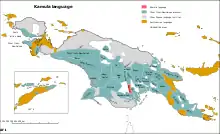Kamula language
Kamula (Kamira, Wawoi) is a Trans–New Guinea language that is unclassified within that family in the classification of Malcolm Ross (2005). Noting insufficient evidence, Pawley and Hammarström (2018) leave it as unclassified.[3]
| Kamula | |
|---|---|
| Wawoi | |
| Region | Western Province, Papua New Guinea |
Native speakers | 800 (1998)[1] |
Trans–New Guinea or unclassified
| |
| Language codes | |
| ISO 639-3 | xla |
| Glottolog | kamu1260 |
| ELP | Kamula[2] |
 Map: The Kamula language of New Guinea
The Kamula language
Other Trans–New Guinea languages
Other Papuan languages
Austronesian languages
Uninhabited | |
| Coordinates: 6.951833°S 142.654804°E | |
Demographics
Kamula is spoken in two widely separated areas,[3]:80 including in Kamiyami village of the Wawoi Falls area in Bamu Rural LLG, Western Province, Papua New Guinea.[4]
Routamaa (1994: 7) estimates that there are about 800 speakers of Kamula located in 3 villages in Western Province, with no dialectal differences reported.[5] This is because the Kamula had originally lived in camps near Samokopa in the northern area, but a group had split off and moved to Wasapea in the south only around 50 years ago.[6]:14
- Kesiki, at Wawoi Falls in Bamu Rural LLG (main village) (6.951833°S 142.654804°E)
- Samokopa in Bamu Rural LLG (one day's walk from Kesiki) (6.931064°S 142.746689°E)
- Wasapea (Kamiyami[7]) in Gogodala Rural LLG (seven days' walk, or 90 km to the south of Kesiki) (7.889003°S 142.648998°E)[8]
In the northern villages of Kesiki and Samokopa, Kamula children were reported as preferring to speak Doso over Kamula. A minority of Kamula people in the northern area also live in Dibiyaso-speaking villages, where they are multilingual in Kamula, Doso, and Dibiyaso. Kamula people in the southern village of Wasapea are also fluent in Gogodala.[7]
Classification
The little data that exists for Kamula pronouns does not fit in with the neighboring East Strickland or Bosavi languages (though 1sg nê likely reflects proto-TNG *na), so Kamula is best left as an unclassified language an independent branch of Trans–New Guinea pending further study.
Attested pronouns are 1sg nɛ̃, 2sg wɛ̃, and ̩pl diɛ.
Phonology
Kamula phonology:[9]
Consonants
Kamula has 12 consonants.
| Bilabial | Dental | Alveolar | Palatal | Velar | Glottal | |
|---|---|---|---|---|---|---|
| plosive | p | t̪ | d | k ɡ | ||
| nasal | m | n | ||||
| fricative | s | h | ||||
| approximant | w | j | ||||
| lateral approximant | l |
Vowels
Kamula has 7 vowels.
| Front | Central | Back | |
|---|---|---|---|
| close | i | u | |
| close-mid | e | o | |
| open-mid | ɛ | ɔ | |
| open | a |
Vocabulary
The following basic vocabulary words are from Dutton (2010), Reesink (1976), and Shaw (1986), as cited in the Trans-New Guinea database:[10]
gloss Kamula head dokupala; tɔkɔnʌlʌ hair kokosasi; kɔkɔsʌse ear molo; mɔlɔ eye inʌma; inoma nose mu; mũ tooth ɛpe tongue te; tɛ leg ɛtɛ; hetei louse iyʌ; iya dog ɛsemala; esemʌlʌ pig ʌľiʌ bird tea egg temoko; temɔkɔ blood umali; umʌ:li bone ɛľu; ɛro skin kapala; kʌpʌlʌ breast mɛmɛ tree dali; tʌli man ɔpɔlʌimi; opřami woman eya; ɛ̃yã sun sali; sʌľi moon mama; mʌmʌ water yu fire deľʌpʌ; dřaƀa stone ewʌľʌ; yawařa road, path api name hi eat dampřoma; tʌɛdɔma one hatropɛ; hʌtɔlɔp two dapiamɛtɛ; depiʌmɛtɛ
References
- Kamula at Ethnologue (18th ed., 2015)
- Endangered Languages Project data for Kamula.
- Pawley, Andrew; Hammarström, Harald (2018). "The Trans New Guinea family". In Palmer, Bill (ed.). The Languages and Linguistics of the New Guinea Area: A Comprehensive Guide. The World of Linguistics. 4. Berlin: De Gruyter Mouton. pp. 21–196. ISBN 978-3-11-028642-7.
- Eberhard, David M.; Simons, Gary F.; Fennig, Charles D., eds. (2019). "Papua New Guinea languages". Ethnologue: Languages of the World (22nd ed.). Dallas: SIL International.
- Routamaa, Judy. 1994. Kamula grammar essentials.
- Routamaa, Judy. 1997. Orthography paper Kamula, Western province.
- Routamaa, Iska and Judy Routamaa. 1996. Dialect survey report of the Kamula language, Western province.
- United Nations in Papua New Guinea (2018). "Papua New Guinea Village Coordinates Lookup". Humanitarian Data Exchange. 1.31.9.
- Routamaa, Judy. 1995. Kamula phonology essentials.
- Greenhill, Simon (2016). "TransNewGuinea.org - database of the languages of New Guinea". Retrieved 2020-11-05.
- Ross, Malcolm (2005). "Pronouns as a preliminary diagnostic for grouping Papuan languages". In Andrew Pawley; Robert Attenborough; Robin Hide; Jack Golson (eds.). Papuan pasts: cultural, linguistic and biological histories of Papuan-speaking peoples. Canberra: Pacific Linguistics. pp. 15–66. ISBN 0858835622. OCLC 67292782.